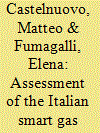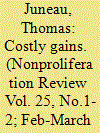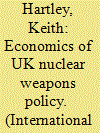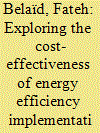|
|
|
Sort Order |
|
|
|
Items / Page
|
|
|
|
|
|
|
| Srl | Item |
| 1 |
ID:
150926


|
|
|
|
|
| Summary/Abstract |
Existing policies of household biogas projects focus mainly on supports on construction, but less consider management and maintenance, resulting in high scrap rate and waste of resources. Alternative policies must be explored to balance construction and operation. Taking the costs and benefits from a typical rural household biogas project, this paper assesses the economic performance at three different subsidy levels, i.e., no subsidy, existing standard and positive externality based standard. Furthermore three subsidy alternatives, one-time, annual and combined option are applied to the externality based standard. The results show that household biogas digesters have unsatisfactory economic performance without any subsidy and even in current subsidy policies. Environmental benefits of the digester were estimated as 2732 Chinese Yuan, significantly larger than existing subsidy standard. To keep continuous work during the 20-year lifespans of digesters, the income disparity of farmers among regions must be considered for policy application. With the increasing of labor costs, the ratio of initial subsidies must be reduced. These results provide policy implications to the future development of biogas projects in terms of both their construction and follow-up management, reuse of the abandoned digesters as well as the exploitation of other emerging renewable energy projects.
|
|
|
|
|
|
|
|
|
|
|
|
|
|
|
|
| 2 |
ID:
124610


|
|
|
|
|
| Summary/Abstract |
The introduction of smart metering is one of the core elements in recent European policies targeting environmental sustainability and competitiveness of energy markets. Following the roll-out of smart electricity meters, in 2008 the Italian regulator designed an ambitious deployment program also for smart gas meters, that was recently modified in both scope and timing.
This paper assesses Italy's original and current deployment plans, with a specific focus on the results of its cost-benefit analysis. In light of the evidence derived from the literature, we observe that the case for the roll-out of smart gas meters in Italy was not supported by a strong emphasis on energy savings but rather focused on increasing efficiency of the Italian gas market; in this respect, we argue that options other than smart gas metering should also be considered. Moreover the Italian cost-benefit analysis, which mostly dealt with the potential cost savings for distributors and suppliers, led to ambiguous results in terms of net present values; thus, we believe that an updated assessment would be extremely useful. Finally, in terms of technological choices, our analysis positively evaluates the regulator's recent proposal to consider a dual-fuel solution for the mass market deployment.
|
|
|
|
|
|
|
|
|
|
|
|
|
|
|
|
| 3 |
ID:
072169


|
|
|
| 4 |
ID:
160986


|
|
|
|
|
| Summary/Abstract |
Iran’s nuclear ambitions have been at the center of Middle Eastern politics and a global nonproliferation source of concern for almost twenty years. Much has been written on the topic, but one important question has received less attention: was it beneficial for the Islamic Republic? How have the gains and losses associated with its nuclear pursuits compared with each other? This article attempts to provide a comprehensive assessment of the costs and benefits of Iran’s nuclear program. We start with an overview of the literature on why states pursue nuclear programs. This allows us to build a list of objectives that states can hope to achieve through their nuclear ambitions. We use these as yardsticks to assess the gains Iran has reaped and the losses it has incurred. This leads to the conclusion that, although Iran has earned some benefits from its nuclear program, these have been costly; ultimately, the costs have exceeded the benefits. We conclude by reflecting on what the Iranian case tells us more broadly about the study of nuclear proliferation.
|
|
|
|
|
|
|
|
|
|
|
|
|
|
|
|
| 5 |
ID:
162897


|
|
|
|
|
| Summary/Abstract |
We use a detailed power sector model, E4ST, to project multi-decade effects of preventing a set of unprofitable generators from retiring. We simulate the “Grid Resiliency Pricing Rule” proposed by the US Department of Energy in 2017, and several variations, as an illustrative case study for similar national, regional, or state policies in the US or elsewhere. In the proposed policy, eligible coal and nuclear generators would be guaranteed revenues sufficient to ensure profitability. The simulation results show that, in 2025, $7.6 billion in subsidy is required to guarantee coal and nuclear generator profits. If in effect from 2020 to 2045, the policy delays the retirement of 25 GW of coal capacity and 21 GW of nuclear capacity, causes 27,000 premature deaths, increases carbon dioxide emissions by 420 million short tons, and has costs with a net present value of $263 billion during that period. The policy's net non-environmental cost for electricity end-users is $72 billion and net benefit for generation owners is $28 billion. In alternative scenarios, preventing retirement of only nuclear capacity produces positive total net benefit, while guaranteeing recovery of only going-forward costs shifts $77 billion of costs from customers to generators, but does not reduce emissions or total net cost.
|
|
|
|
|
|
|
|
|
|
|
|
|
|
|
|
| 6 |
ID:
072172


|
|
|
| 7 |
ID:
091701


|
|
|
|
|
| Publication |
2009.
|
| Summary/Abstract |
This paper aims at developing an integrated approach for estimating the employment benefits associated with power-generation technologies. The proposed approach exploits the input-output methodology for estimating the direct, indirect and induced employment effects associated with the energy project in question, as well as two different valuation techniques, namely the "opportunity cost of labour" approach and the "public expenditures" approach, for expressing these effects in monetary terms. This framework has been implemented to estimate the employment benefits resulting from the development of a lignite-fired and a natural gas-fired power plant in Greece, taking into account all the stages of the corresponding fuel cycles that are undertaken domestically. The results of the analysis clearly show that lignite-fired electricity generation results in significant employment benefits amounting to 2.9-3.5 €/MWh in the basic scenario. On the other hand, the employment benefits associated with the examined natural gas unit were estimated at 0.4-0.6 €/MWh in the basic scenario. It is also worth mentioning that the significant environmental externalities of the lignite-fired electricity in Greece that have been presented in a number of studies can only be partially compensated by the estimated employment benefits.
|
|
|
|
|
|
|
|
|
|
|
|
|
|
|
|
| 8 |
ID:
177394


|
|
|
|
|
| Summary/Abstract |
This research investigates the cost-effectiveness of energy performance measures in French residential buildings. We develop an empirical approach based on a multivariate statistical approach and Cost-Benefit analysis. The strength of this research relies on the designing of a large cross-sectional database collected in 2013 including rich technical information of about 1,400 dwellings representative of the French residential sector as well as individual recommendations relative to the energy renovations to be implemented, their investment costs, and energy savings potential. We provide valuable information on the cost-effectiveness of energy renovation measures for the entire housing stock. Results show that low-temperature and condensing boilers, as well as floor insulation, are the most cost-effective energy efficiency measures, which could be inconsistent with actual subsidy policies. We demonstrate that the cost-effectiveness of energy renovation measures is widely dependent on dwelling initial characteristics and the value of the inputs used in the economic indicators such as energy-savings amount, energy price, and the discount rate. Moreover, we provide a classification of French dwellings, which may help policymakers, better identify their target. Finally, we show that the renovation of the entire French residential dwelling stock can lead to a great amount of energy–and CO2–reductions but requires significant financial capacity.
|
|
|
|
|
|
|
|
|
|
|
|
|
|
|
|
| 9 |
ID:
187879


|
|
|
|
|
| Summary/Abstract |
The deterioration of pollution problem has increased environmental disputes. However, little is known about the relationship between intensive judicial oversight and corporate green innovations. Regarding the establishment of environmental courts in China as an almost ideal quasi-natural experiment, this paper identifies the impact and mechanism of environmental courts on corporate green innovations. We find that: (1) environmental courts have a significant positive impact on green innovations. However, by employing instrument variable (IV) strategy to alleviate the endogenous issues, we find environmental courts mainly promote the quantity of green innovations; (2) the positive effect on green innovations is more salient for firms in the industry with high pollution intensity, state-owned enterprises, and firms in regions with stricter mass supervision; (3) environmental courts can improve the efficiency of dealing with environmental disputes and alleviate the collaboration between government and firms. Therefore, it could promote corporate green innovations with the increasing pressure for pollution abatement; (4) environmental courts could cause additional costs to firms, such as crowding out non-green innovations and decreasing corporate TFP in the short term. Meanwhile, the establishment of environmental courts could also achieve specific social welfare effects, which is conducive to improving local environmental quality. This paper provides implications for judicial oversight of regulators on environmental protection.
|
|
|
|
|
|
|
|
|
|
|
|
|
|
|
|
| 10 |
ID:
182559


|
|
|
|
|
| Summary/Abstract |
Ageing workforces due to low fertility rates and higher life expectancies challenge modern industrialized economies. In order to secure economic welfare and to balance public budgets, governments worldwide implement reforms to increase the retirement age. The trend towards a higher retirement age confronts defense sectors that for centuries have been in search of an age structure characterized by ‘youth and vigor’. In this article, we study the economic gains to society when the special retirement age for military personnel in the Norwegian Armed Forces is increased. Combining the literatures on pension, personnel, and military economics, we identify mechanisms crucial to the outcome of a special retirement age reform. Monte Carlo simulation is applied to illustrate the potential impact on the economic net gains of uncertain variables. We find that an increase in the retirement age provides substantial net benefits to society, even under fairly negative assumptions about the consequences for retention, motivation and efforts, and the value of elderly personnel in the Norwegian Armed Forces.
|
|
|
|
|
|
|
|
|
|
|
|
|
|
|
|
| 11 |
ID:
170094


|
|
|
|
|
| Summary/Abstract |
This paper examines the causal effect of public investment on food output by exploiting a panel dataset covering a large central government program (Hundred Billion Plan) in China from 2007 to 2013. Based on an event study methodology, we find that public investment significantly increases food output by 4.34%. We find that the sources of the policy effect come mainly through improving productivity, which is driven by increases in fertilizer inputs by households and by the crowding in local government agricultural investments. Further, an ad-hoc benefit-cost analysis shows that the internal return rate (IRR) is 0.23% over a 20-year period. Our results are robust in terms of the assumption of parallel trends, the confounding effect from an alternative policy, the nonrandom selection issue of policy implementation, the inclusion of alternative sets of control variables, the treatment of outliers and the omitted variable biases.
|
|
|
|
|
|
|
|
|
|
|
|
|
|
|
|
| 12 |
ID:
194985


|
|
|
|
|
| Summary/Abstract |
China has traditionally been regarded as a continental power. However, the 21st Century Maritime Silk Road (MSR), launched in 2013, shapes China's intention to become a global maritime power. The initiative is the most significant contribution to increasing global maritime connectivity in recent decades. The volume and impact of Chinese investments in Europe's seaports are remarkable. This article proposes a fundamental framework to assess who benefits from the initiative. Since quantitative cost-benefit analyses (CBA) hardly apply to multifaceted and partially unquantifiable phenomena, we suggest assessing the MSR by means of a comprehensive qualitative CBA. We opted for a qualitative CBA due to ontological and epistemological reasons: on the one hand, the complex and multilayered nature of the problem is difficult to monetize, and, on the other hand, our argument is not final, as it attempts to assess a given policy before its implementation is sufficiently mature. In this vein, we apply the problem-solving methodology 'analytic hierarchy process'. While the media have disproportionately stressed the negative effects of the MSR, we conclude under this framework that (i) for China, MSR benefits largely outweigh associated costs; (ii) for participating countries, MSR benefits outweigh the associated costs only after cost-mitigating measures are incorporated; and (iii) for non-participating countries, MSR costs outweigh associated benefits.
|
|
|
|
|
|
|
|
|
|
|
|
|
|
|
|
| 13 |
ID:
191535


|
|
|
|
|
| Summary/Abstract |
Taking as reference a cost-benefit analysis of cyberterrorism published in 2004 by Studies in Conflict and Terrorism, this article briefly reviews what happened in the last 15 years in cyberterrorism research, what was correctly forecast, what was wrong and what may happen in the future. Some of the analyses published in during this period have been accurate, indicating that terrorists would use the Web and then social media for supporting operations in financing, recruiting and, especially “propaganda” (information operations), instead of wasting resources in ineffectual cyberattacks against critical infrastructures. The same analyses, however, did not appreciate enough how successful information operations by terrorist groups would have been. Overall, the approach, research methods, findings and forecasting have been quite valid and fruitful and thus they can represent a solid foundation on which scholars of (cyber)terrorism may base their future research.
|
|
|
|
|
|
|
|
|
|
|
|
|
|
|
|
| 14 |
ID:
177392


|
|
|
|
|
| Summary/Abstract |
In 2015, water heaters were the second largest end-user of residential energy. Heat pump (HP) water heaters are several times more efficient than the electric resistance (ER) water heaters common in homes. Currently, North Carolina only requires electric water heaters with tanks larger than 55 gallons to be HP water heaters in new homes, thus allowing inefficient ER water heaters in smaller residences. We considered a hypothetical change to North Carolina's building code requiring HP water heaters in all new residential units constructed in 2018. Using housing data from the US Census Bureau, along with electricity rates and emissions factors from the US Energy Information Administration, we quantified changes in costs expected from tightened efficiency requirements. We estimate that requiring HP water heaters in all new residential construction incurs a one-time statewide cost of $29.5 million, but leads to a total 10-year savings of $108.7 million for residents, as well as 10-year reductions in carbon dioxide emissions of 441,000 metric tons. When rebates from electric utilities are included, total 10-year statewide savings increase to $125.3 million. Our results show that economic and environmental benefits can be realized through changes to state building codes, thus obviating the need for legislative action.
|
|
|
|
|
|
|
|
|
|
|
|
|
|
|
|
|
|
|
|
|